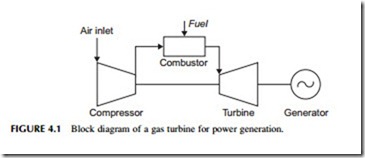GAS TURBINE PRINCIPLE
A gas turbine is a machine that harnesses the energy contained within a gas— either the kinetic energy of motion of a flowing gas stream or the potential energy of a gas under pressure—to generate rotary motion. In the case of a gas turbine this gas is usually, though not necessarily, air. The earliest human-made device of this type for harnessing the energy in moving air was a windmill described by Hero of Alexandria in the 1st century AD.
This earliest known windmill was a near relative of today’s wind turbine, which though clearly a type of gas turbine, is far removed from the modern gas turbine concept. Closer in concept to the gas turbine was the smokejack, developed in the middle of the 2nd century AD. As described in the 17th century by John Wilkins, Bishop of Chester, the smokejack used hot air rising through a chimney to move windmill vanes within that chimney and drive a shaft that could be used to rotate a spit for roasting meat.
This principle of harnessing moving air within an enclosed chamber to create rotary motion for driving machinery was developed further during the industrial revolution. Following this principle, the 19th century saw a number of predecessors to the gas turbine. These used some form of compressor to generate a human-made flow of pressurized air that was fed into an enclosed turbine. In these machines the compressor was usually separate from the turbine.
The direct ancestor of the modern gas turbine was first outlined in a patent granted to German engineer F. Stolze in 1872. In Stolze’s design, as in that of all modern gas turbines, an axial compressor was used to generate a flow of pressurized air. This air was then mixed with fuel and ignited, creating a very energetic flow of hot, high-pressure gas that was fed into a turbine. Crucially, the compressor and the turbine were mounted on the same shaft (Figure 4.1).
Whereas a gas turbine supplied with pressurized gas from a separate compressor must inevitably rotate provided it has been designed correctly, the arrangement patented by Stolze need not necessarily do so. This is because the energy to operate the compressor that provides the pressurized air to drive the turbine is produced by the turbine itself. Thus, unless the turbine can generate more power than is required to turn the compressor—the energy for this being provided by the combustion of fuel in the compressed air that same compressor has
produced—the machine will not function. This, in turn, demands efficient compressors and turbines. Both need to operate at a minimum efficiency of around 80%. Only if this condition is met will the turbine operate in a continuous fashion.
The turbine system described by Stolze, although envisaging virtually all the features of a modern gas turbine, was not capable of sustained operation because the machinery sophisticated enough to achieve it had not yet been developed. The first machine that was able to operate in a sustained fashion was built in Paris in 1903. This, though, did not have a rotary compressor on the same axis as the turbine. That honor fell to a machine built by Aegidus Elling in Norway and operated later in 1903. In Elling’s machine the inlet gas temperature was 400 oC, high for its time though much lower than gas turbine inlet temperatures today.
Development of the gas turbine based on this principle continued through the early years of the 20th century with the aim of generating either a flow of compressed air, rotary motion, or both for industrial use. Then, during the 1930s, the potential of the gas turbine to provide the motive force for flight was recognized and aircraft with jet engines based on the gas turbine were developed in Germany, Great Britain, and the United States. These led, in turn, to the modern aircraft engines that power the world’s airline fleets.
During the late 1970s and early 1980s, as already noted, gas turbines began to find a limited application in power generation, and during the 1990s this use expanded with development of combined cycle power plants.
